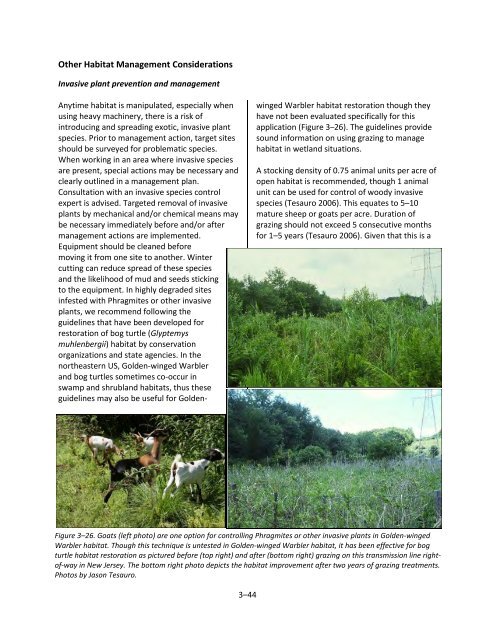Review and download Chapter 3 - Golden-winged Warbler Working ...
Review and download Chapter 3 - Golden-winged Warbler Working ...
Review and download Chapter 3 - Golden-winged Warbler Working ...
Create successful ePaper yourself
Turn your PDF publications into a flip-book with our unique Google optimized e-Paper software.
Other Habitat Management Considerations<br />
Invasive plant prevention <strong>and</strong> management<br />
Anytime habitat is manipulated, especially when<br />
using heavy machinery, there is a risk of<br />
introducing <strong>and</strong> spreading exotic, invasive plant<br />
species. Prior to management action, target sites<br />
should be surveyed for problematic species.<br />
When working in an area where invasive species<br />
are present, special actions may be necessary <strong>and</strong><br />
clearly outlined in a management plan.<br />
Consultation with an invasive species control<br />
expert is advised. Targeted removal of invasive<br />
plants by mechanical <strong>and</strong>/or chemical means may<br />
be necessary immediately before <strong>and</strong>/or after<br />
management actions are implemented.<br />
Equipment should be cleaned before<br />
moving it from one site to another. Winter<br />
cutting can reduce spread of these species<br />
<strong>and</strong> the likelihood of mud <strong>and</strong> seeds sticking<br />
to the equipment. In highly degraded sites<br />
infested with Phragmites or other invasive<br />
plants, we recommend following the<br />
guidelines that have been developed for<br />
restoration of bog turtle (Glyptemys<br />
muhlenbergii) habitat by conservation<br />
organizations <strong>and</strong> state agencies. In the<br />
northeastern US, <strong>Golden</strong>-<strong>winged</strong> <strong>Warbler</strong><br />
<strong>and</strong> bog turtles sometimes co-occur in<br />
swamp <strong>and</strong> shrubl<strong>and</strong> habitats, thus these<br />
guidelines may also be useful for <strong>Golden</strong>-<br />
3–44<br />
<strong>winged</strong> <strong>Warbler</strong> habitat restoration though they<br />
have not been evaluated specifically for this<br />
application (Figure 3–26). The guidelines provide<br />
sound information on using grazing to manage<br />
habitat in wetl<strong>and</strong> situations.<br />
A stocking density of 0.75 animal units per acre of<br />
open habitat is recommended, though 1 animal<br />
unit can be used for control of woody invasive<br />
species (Tesauro 2006). This equates to 5–10<br />
mature sheep or goats per acre. Duration of<br />
grazing should not exceed 5 consecutive months<br />
for 1–5 years (Tesauro 2006). Given that this is a<br />
Figure 3–26. Goats (left photo) are one option for controlling Phragmites or other invasive plants in <strong>Golden</strong>-<strong>winged</strong><br />
<strong>Warbler</strong> habitat. Though this technique is untested in <strong>Golden</strong>-<strong>winged</strong> <strong>Warbler</strong> habitat, it has been effective for bog<br />
turtle habitat restoration as pictured before (top right) <strong>and</strong> after (bottom right) grazing on this transmission line rightof-way<br />
in New Jersey. The bottom right photo depicts the habitat improvement after two years of grazing treatments.<br />
Photos by Jason Tesauro.


